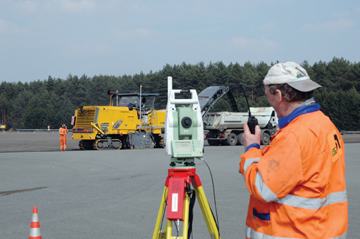Perfect Evenness Using 3D Control
Claudia Fernus , Wirtgen GmbH
Collaboration spéciale

Elk tests, brake testing, extreme driving situations – car manufacturers test all that and more on large “dynamics areas”. German car manufacturer VW owns a 250,000 m² large testing ground in the vicinity of Wolfsburg, the surface course of which no longer met the high demands placed on it. Rehabilitation involved the use of two Wirtgen W 2200 high-performance milling machines fitted with a 3D control system, which removed the surface and binder courses in two machine passes. In the process, they created a surface with a new, defined horizontal position.
Remodel terrain using 3D control
The milling job was a typical application of the 3D control system as the existing surface deviated from the specified plane in all three directions. Rehabilitation using the 3D control system was the only method that would allow reshaping of the surface at the same time. It works independently of references on the ground, instead using a digital terrain model as specified parameter for the milling depth. In addition, the Wirtgen milling machine equipped with the 3D control system delivers the desired milling accuracy in the millimetre range. Requirements on the testing ground near Wolfsburg were extremely high: The horizontal position of the milled area was allowed to deviate from the specified level by a maximum of ± 2 mm.
 SAT Straßensanierung GmbH was awarded the contract for carrying out this highly demanding job. “For the job in Wolfsburg, two of our W 2200 cold milling machines, which usually work with wirerope sensors or ultrasonic sensors, were converted to the 3D control system,” says site manageress Aleksandra Rompa, explaining the setup of the machines. This is possible because the hardware and software of the Wirtgen levelling systems include a standard pre-installation for the 3D systems of common manufacturers. SAT Straßensanierung GmbH was awarded the contract for carrying out this highly demanding job. “For the job in Wolfsburg, two of our W 2200 cold milling machines, which usually work with wirerope sensors or ultrasonic sensors, were converted to the 3D control system,” says site manageress Aleksandra Rompa, explaining the setup of the machines. This is possible because the hardware and software of the Wirtgen levelling systems include a standard pre-installation for the 3D systems of common manufacturers.
Success factor W 2200
Several reasons were speaking in favour of using the W 2200 in this large project. From a technical viewpoint, the machine impresses with its high weight, which ensures an extremely smooth operation and minimizes vibrations at the prism. The W 2200 was the prime choice also because of its high economic efficiency. In this case, its milling width of 2.20 m was a particularly valuable asset: It minimized the time needed for reversing the machine and helped to speed up completion of the project.
500 000 m² in just seven weeks
At the client’s request, the asphalt pavement on the 250 000 m² large area was removed in two separate layers. In actual fact, the two high-performance milling machines therefore needed to work a total area of 500 000 m². They needed seven weeks altogether to complete this job. Holger Oldach, manager of the milling division at SAT in Hamburg, is “highly satisfied with both the progress and the outcome of the project. The two W 2200s did an excellent job, and with the 3D control system produced a new profile which precisely adheres to the parameters specified by the digital terrain model. On the whole, this technology isn’t any more complicated than other levelling methods. Know-how and experience in surveying are important, however, in order to be able to solve demanding tasks like this one.”
 Fast and easy setup Fast and easy setup
To get the cold milling machine ready for operation, a prism is mounted on a mast on the machine. In addition, the system computer of the 3D control system is plugged into the Wirtgen automatic levelling system and connected to a radio transmitter. The modules are connected quickly and easily by plugs. The specified profile of the completed area needs to be defined prior to commencement of the milling operation. Planners or surveyors establish these data and install them on the system computer of the 3D control system.
Precision milling with automatic target recognition
During the milling operation, the prism is tracked by a total station with automatic target recognition, a so-called tachymeter. The prism serves as a reference for the specified level of the milled surface. As soon as the milling machine begins to move, the total station keeps tracking the prism automatically, continuously locating its position in space. The measuring data are transmitted by radio to the system computer on the machine. If the measured level deviates from the specified value, the system computer forwards the information to the machine control system. The cold milling machine responds in a split second by correcting the milling depth.
The operating principle of 3D control
The Wirtgen 3D control system comprises four main components: a prism on the cold milling machine, a total station which tracks the prism automatically, a radio connection between the total station and the cold milling machine, and a system computer on the machine. It is particularly suitable for milling large surfaces which are to be given a new profile, for example, on airports or special areas as described above. The technology can also be used, however, for the highly precise modelling of complicated profiles on other traffic areas.
Cet article est également publié en français
|







